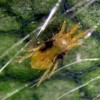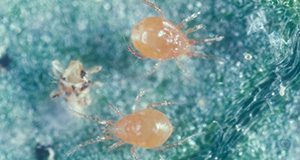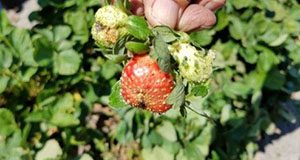The aim of this 9-page document is to inform Florida strawberry producers and Extension personnel on the compatibility of registered miticides and insecticides with commercially available predatory mites used as biological controls. Written by Braden Evans, Karol Krey, and Justin Renkema and published by the UF/IFAS Entomology and Nematology Department, August 2018.
http://edis.ifas.ufl.edu/in1216
Tag: Strawberry Pest Management
Foliar or Bud Nematodes in Florida Strawberries
Foliar or bud nematodes are little-known nematodes that caused “crimp disease” in Florida strawberries in the early 1900s. Recently, these foliar nematodes have been observed again in the state, and seem to have come in with transplants from outside Florida. Foliar/bud nematodes can devastate a crop of strawberries. Plants become stunted with curled up leaves, and produce few or no flowers or fruits. This 7-page fact sheet written by J. Desaeger and J. Noling and published by the UF/IFAS Department of Entomology and Nematology provides much-needed information on these little-understood pests, summarizing the different types of foliar nematodes, their biology, life cycle, damage symptoms, survival strategies, dissemination, and management options.
edis.ifas.ufl.edu/in1184
Pesticide Options for Insect, Mite, and Mollusk Management in Commercial Strawberry Production in Florida (ENY689/IN486)
 Effective management of arthropod and gastropod pests of strawberry is critical to the profitability of the industry and requires that pests be detected in a timely manner through systematic scouting. Appropriate control measures should be applied as conditions warrant. The tables in this 22-page fact sheet list pesticides that are presently available to commercial strawberry producers in Florida and are organized alphabetically by major pest groups. Written by James F. Price, Curtis Nagle, and Susan E. Webb, and published by the UF Department of Entomology and Nematology, April 2013.
Effective management of arthropod and gastropod pests of strawberry is critical to the profitability of the industry and requires that pests be detected in a timely manner through systematic scouting. Appropriate control measures should be applied as conditions warrant. The tables in this 22-page fact sheet list pesticides that are presently available to commercial strawberry producers in Florida and are organized alphabetically by major pest groups. Written by James F. Price, Curtis Nagle, and Susan E. Webb, and published by the UF Department of Entomology and Nematology, April 2013.
http://edis.ifas.ufl.edu/in486
Causes and Management of Insect and Mite Resistance in Strawberry Production (ENY841/IN713)
 Episodes of pest resistance to popular pesticides can cause yield losses, reduction of fruit quality, added control costs, environmental degradation, and emotional stress among farmers. These consequences can be alleviated if resistance management is practiced throughout the strawberry industry. If they minimize pesticide application by depending more on biological and cultural pest control measures, and take care not to expose pest populations to pesticides with identical modes of action, growers can avoid causing pesticide resistance. This 8-page fact sheet was written by James F. Price and Curtis Nagle, and published by the UF Department of Entomology and Nematology, November 2012.
Episodes of pest resistance to popular pesticides can cause yield losses, reduction of fruit quality, added control costs, environmental degradation, and emotional stress among farmers. These consequences can be alleviated if resistance management is practiced throughout the strawberry industry. If they minimize pesticide application by depending more on biological and cultural pest control measures, and take care not to expose pest populations to pesticides with identical modes of action, growers can avoid causing pesticide resistance. This 8-page fact sheet was written by James F. Price and Curtis Nagle, and published by the UF Department of Entomology and Nematology, November 2012.
http://edis.ifas.ufl.edu/in713
HS1175 Managing Yellow and Purple Nutsedge in Florida Strawberry Fields
HS1175, a 3-page illustrated fact sheet by Andrew W. MacRae, gives management guidelines for these perennial weeds that are well adapted for growth in plasticulture production systems. Published by the UF Department of Horticultural Sciences, May 2010.
http://edis.ifas.ufl.edu/hs1175
HS1172 Florida Pusley Biology and Control in Fruiting Vegetables, Cucurbits, and Small Fruits
HS1172, a 3-page illustrated fact sheet by Andrew W. MacRae, describes this drought-resistant annual with hairy leaves and stems that is common in row middles, strawberry production fields, and organic mulch for highbush blueberries — classification, seedling identification, mature plant, management considerations, and classical control. Includes reference. Published by the UF Department of Horticultural Sciences, May 2010.
http://edis.ifas.ufl.edu/hs1172

